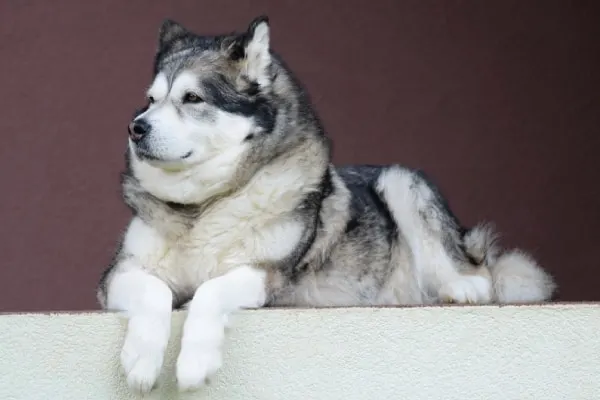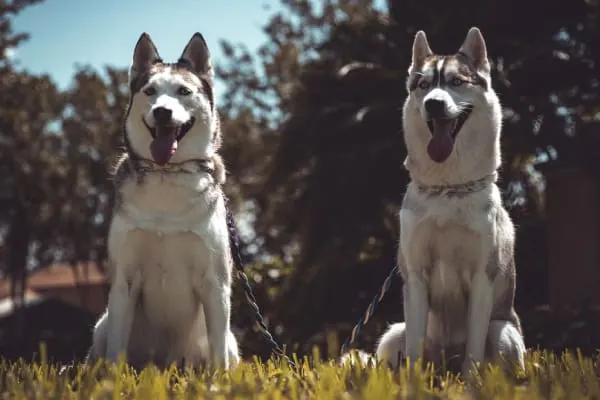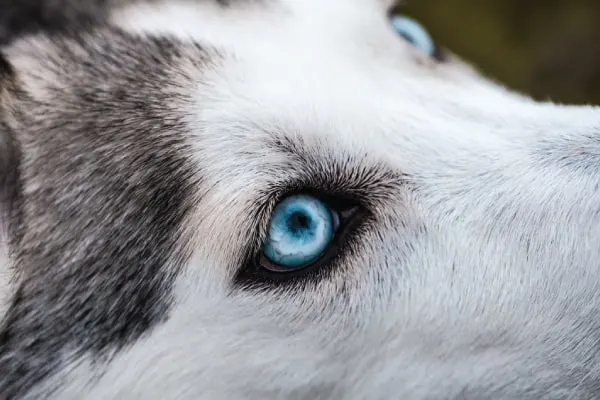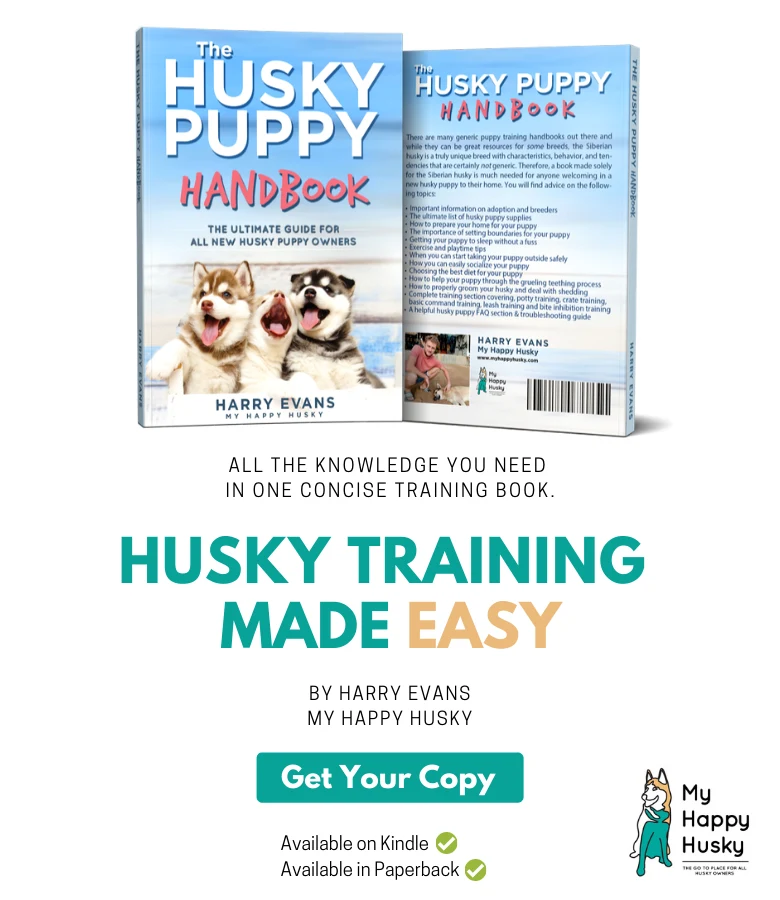Siberian Huskies and Alaskan Malamutes seem really alike, and it’s easy for many people (even their own pet parents) to mix them up.
But, guess what? They’re not as similar as you might think. There are some fun differences between the two that might surprise you!
This article will be the complete breed comparison for the Husky and the Malamute. I’ll go over everything to know about each breed, their similarities, and their differences.
Husky Vs Malamute! Here’s what you need to know…
Table of Contents
Husky vs Malamute Traits Comparison
Let’s start with some easy comparison facts so you can see the differences and similarities right off the bat. Further down I’ll cover everything in a little more detail.
| Info | Siberian Husky | Alaskan Malamute |
|---|---|---|
| Size: (Average) | Medium Breed | Large Breed |
| Height: (Average) | 20-23 Inches | 22-25 Inches |
| Weight: (Average) | Male: 45-60 lbs Female: 35-50 lbs | Male: 65-90 lbs Female: 55-75 lbs |
| Coat: | Medium length, Double-Coated | Long length, Double Coated |
| Color: | Varies from white, gray, agouti, black, and shades of red | Varies from white, gray, agouti, black, and some shades of brown |
| Lifespan: | 11-14 | 10-13 |
| Cost: | $800 – $2000 | $1000 – $3000 |
| Intelligence: | Medium to high intelligence | Medium intelligence |
| Trainability: | Difficult. Stubborn & mischievous | Difficult. Stubborn & mischievous |
| Obedience: | Obedient but very stubborn & independent | Obedient but very stubborn & independent |
| Sociability: | Very sociable & likes company | Less sociable, but can be trained to be sociable |
| Friendliness: | Naturally very friendly | Less friendly and more aloof |
| Energy Level: | Very high | High |
| Destructive Behavior: | If untrained and left alone, very destructive | If untrained and left alone, very destructive |
Surprising Differences: Husky vs Malamute

Let’s take a look at some of the differences between Siberian Huskies and Alaskan Malamutes. As these two breeds seem so similar upon first impressions, I’ll cover some differences you may not have known.
Differences between Huskies and Malamutes
Top differences between the Husky and the Malamute:
- Huskies are much more naturally friendly than Malamutes. Huskies will befriend a stranger whereas a Malamute could show some aggression or at least be suspicious
- Malamutes cannot have blue eyes! Malamutes will only ever have brown eyes, as the breed does not contain the merle gene mutation like huskies do.
- Malamutes are much more loyal to their owners than Huskies. Huskies tend to prefer their canine pack, Malamutes prefer their owners
- Huskies would make terrible guard dogs. Malamutes, if trained correctly can make fantastic guard dogs
- Despite being hard to train Huskies are far more intelligent and understanding compared to Malamutes.
- Huskies are more happy to live with other dogs or Huskies. Malamutes prefer to live with humans.
- Huskies are more social than Malamutes. Huskies will make friends with other dogs and strangers. Malamutes can’t be trusted to behave well when meeting new dogs.
History of the Siberian Husky
The Siberian Husky was originally bred thousands of years ago by a nomadic group of people known as the Chukchi People. The Chukchi People were from Eastern Siberia.
The Husky was bred to help this tribe with their nomadic, hunter-gatherer lifestyle. Constantly moving around and hunting for survival. The Husky’s role would be to help move the heavy loads, cargo and people across vast distances in terrible freezing conditions.
Siberian Huskies would soon become famous when they were exported to Alaska in 1908 and used as sled dogs during the gold rush. After their amazing abilities were recognized, they were used in sled-dog racing, one of the most popular sports in that region.
After an elite team of Siberian Huskies saved the lives of hundreds of people from a Diptheria outbreak, they became very well known. After this, Huskies appeared in multiple shows and even Disney movies. The Siberian Husky then became a popular household family pet.
Recommended Read: Can Malamutes Have Blue Eyes Like Huskies?
History of the Alaskan Malamute
Alaskan Malamutes have a similar history to the Siberian Husky. These were dogs of an indigenous group of people known as Mahlemuts. Now you can tell where they got their name from!
The Mahlemut tribe originally migrated from Siberian to America, bringing their trusty Malamutes with them, who helped them move heavy loads and hunt for their survival.
It may be said that Malamutes are in fact the oldest breed linked to man, which could date back 12,000 to 20,000 years ago (estimates took from bone discovery)
When the gold rush started in Alaska in the 1870’s there suddenly become a huge increase of people trying their luck to find gold. Consequently, Malamutes due to their power and size became the No.1 choice for pulling heavy sled loads across the land. With so many people flocking to Alaska and buying Malamutes, they became less available, which is when the crossbreeding started. There was so much crossbreeding of the Malamute, that the purebred Malamute almost became extinct. The crossbreds were not as resilient as the purebred and naturally died out. Because of this, purebred Malamutes are still with us today.
What’s The Siberian Husky Like?

Huskies are stunning dogs and will definitely catch the attention of passers-by. A lot of people think Huskies look like wolves, when in fact, the Alaskan Malamute looks more like a wolf due to its sheer size.
Siberian Huskies make great family pets and are naturally very friendly and social. Huskies can be very loving and affectionate and usually always desire the attention of their owners.
Huskies are so friendly that they don’t make good guard dogs. For people who don’t know about Huskies, they LOOK like a guard dog, but the chances are they will lick an intruder to death than bite them.
The Siberian Husky is officially classed as of average intelligence, but after we dove in deep on this topic, we discovered this isn’t really the truth. Huskies are in fact very smart and can be trained to a high level, but this is very difficult and can take a long time.
Despite being intelligent, Huskies can be quite stubborn and independent. This is likely their old pack instinct coming through. Huskies are able to think for themselves and will sometimes give the impression “they don’t need you”
Huskies best suit a family or someone who lives a very active, outdoor lifestyle. They absolutely need to run and have a lot of physical and mental exercise daily. If this natural need is not met, Huskies are known to become very destructive, disobedient and present general behavioral issues.
What’s The Alaskan Malamute Like?
To start with, Alaskan Malamutes are much bigger than Huskies, they do have a similar shaped head, ears, snout, eyes and coat, just considerably bigger.
Malamutes are friendly and loving towards their owners, but they can be a little aloof to strangers and other dogs. The protectiveness and courageousness qualities in Malamutes make them a great guard dog (with proper training)
Malamutes are of average intelligence and need to be trained in order to be well-behaved. This training will prove difficult due to the natural independence built into Malamutes.
Due to the past, Malamutes, like Huskies need a lot of exercise both physical and mental to be content and satisfied. If these needs are not met, the Malamute can be very destructive and badly behaved.
Malamutes are not good for small houses or apartments, their size and need for space typically require a bigger home. This breed also best suits a family or person with a very active lifestyle.
Which Would Make a Better Family Pet? Husky vs Malamute
If you’re considering getting either a Husky or Malamute and you have a family you should consider the following.
It ultimately depends on what kind of dog you want for your family and whether or not you have children.
If you have children, do you want a guard dog that will be able to protect your children? or would you want a dog with no aggressive tendencies because you do have children?. There’s a clear difference between the two breeds with this one so it’s easy. Malamutes make guard dogs and have aggressive tendencies, Siberian Huskies are too friendly and will not be a good guard dog.
Both breeds are very affectionate and loving towards their owners and close family, although Huskies will tend to display their independent nature more than Malamutes. This may not be a good match if you have young children who will constantly want to bundle and hug your Husky. The Malamute may be a better option here.
It’s hard to really say which one is better because it depends on each individual family. No two families are the same, some will better suit a Husky and some would better suit a Malamute.
Do Huskies or Malamutes Shed More?
Shedding is actually a big concern for many new dog owners. How much hair will you need to sweep off your floors every day is a big question, and rightfully so.
Malamutes have longer hair than Huskies, but this doesn’t make too much difference in the amount they will both shed.
Both breeds will shed just as much as each other. There will all-around general shedding, and then two big blowouts twice a year, usually before big seasonal changes in weather and temperature.
If you aren’t prepared to spend time every day sweeping or vacuuming, these may not be the best breeds for you!
Husky vs Malamute Training

Training is very important for all dogs and can vary drastically between each breed. But how do Huskies compare to Malamutes when it comes to their intelligence and trainability?
Siberian Huskies are more intelligent and cunning than Alaskan Malamutes, but both will be just as hard to train. Despite its difficulty, training will be absolutely necessary for both breeds, and if not given, will likely result in a disobedient destructive dog.
Siberian Huskies show stronger independence and stubbornness than Malamutes so training may be a little bit more frustrating with a Husky. Huskies tend to have this “I do what I want when I want” mindset.
It’s commonly heard that Siberian Huskies and sometimes Malamutes, are not good dogs for beginner dog owners. I personally believe anyone can successfully raise a Husky or Malamute, but you have to be ready, and give A LOT of your time, energy, and focus. If you are a busy person, this likely isn’t the breed for you.
Husky vs Malamute Sociability
Like I mentioned above, sociability is an important thing to consider before you get any dog. A dog’s sociability is their tendency to be friendly towards strangers or other dogs. This trait can also be linked to aggression.
Usually, if you aren’t worried about getting a dog for guard dog purposes, the friendlier the better. Huskies are naturally sociable and are generally more friendly than malamutes.
Malamutes still are friendly and loving, but they are capable of showing aggression and can be fiercely protective.
If you intend on spending a lot of time in public places with your dog, taking them for walks in the park or exercising them around other animals, this is something you will absolutely have to consider. It may not end well with a Malamute if you stroll into a park filled with other dogs bounding up close.
Do Malamutes Howl Like Huskies?
If you’re looking to get either an Alaskan Malamute or Siberian Husky, then you’re looking for a noisy household!
Yes, Malamutes do howl like Huskies, in fact, their vocabulary is pretty similar. Both breeds tend to howl, talk, sing, whine, yelp, and much more.
Both are noisy, but it seems that Malamutes use their bark a lot more than Huskies do. It’s actually quite rare to hear huskies bark, they will usually howl and chirp.
If you live somewhere with a lot of sirens or near to the road, expect your Malamute or Husky to respond almost every time. Why do they do this? Well, sirens along with many other noises, including baby cries, trigger an instinctive response in our fluffy friends and they will naturally howl back. Researchers believe Malamutes and Huskies respond like this for two reasons, to help a lost pack mate find their way back to them, and to comfort their puppies (or baby)
Common Health Issues in Huskies and Malamutes
Each of these breeds come with their share of common health issues. Siberian Huskies tend to have slightly fewer health concerns, this is likely due to their smaller size, height, and weight.
Siberian Husky Health Issues
Common health issues found in Huskies:
- Cataracts
- Progressive Retinal Atrophy
- Corneal Dystrophy
- Hip Dysplasia
- Follicular Dysplasia
- Zinc Deficiency
- Hypothyroidism
Alaskan Malamute Health Issues
Common health issues found in Malamutes:
- Hip Dysplasia
- Chondrodysplasia
- Polyneuropathy
- Hypothyroidism
- Haemophilia A
- Haemophilia B
- Progressive Retinal Atrophy
- Von Willebrand Disease
Related Article: How to Keep Alaskan Malamute Cool in Summer
Last Thoughts
Hopefully, now, you know the differences and similarities between both of these amazing breeds.
Often considered to be very similar, you now know they can be quite different. Always do your research thoroughly before choosing any of these breeds.
Most Recommended For Huskies 🐶
Best Brushes For Husky Shedding ⭐
My two favorite brushes for a beautiful coat are a simple Undercoat Rake and a Slicker Brush. These brushes when used together will de-shed and maintain your husky’s coat better than anything else.
Best Online Training Program For Huskies⭐
Brain Training For Dogs has become increasingly popular with Siberian Huskies in the last few years. It’s now recognized as perhaps the best way to train a husky in the most stress-free, positive way.
Best Husky Puppy Book ⭐
If you would like to support My Happy Husky directly and have an easy to read and entertaining guide for training your husky puppy, check out my book The Husky Puppy Handbook on Amazon. All purchases are greatly appreciated.

Disclaimer
The advice given in this article is for educational purposes only and does not constitute professional advice in any context. Before making any decisions that may affect the health and/or safety of your dog, you should always consult a trained veterinarian in your local area. For the FULL disclaimer Visit HereCopyright Notice: The content produced and published on My Happy Husky is unique and original. My Happy Husky makes an active effort to search for plagiarized content using plagiarism detection software. If plagiarized content is found, action will be taken.
